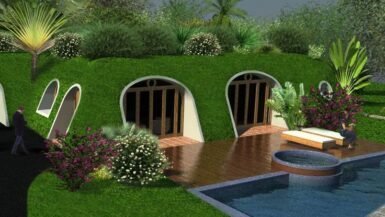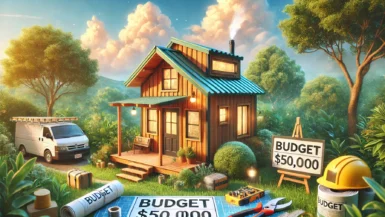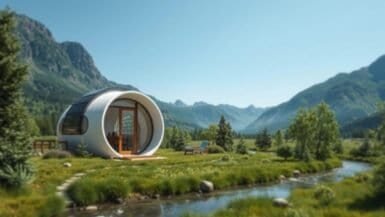Creating a budget for a tiny house is key to affordable living. When you think about downsizing, you might wonder how to save money. A good tiny house budget ensures your new life is both cheap and sustainable.

Understanding what an affordable tiny house budget looks like is important. By focusing on what’s important and making smart choices, you can live affordably. This guide will help you create a budget for a tiny house. You’ll learn how to save money and enjoy the freedom of tiny house living.
Contents
Understanding the Basics of a Budget for Tiny House
Living in a mini green home requires a budget to make it affordable. A tiny house cost breakdown shows you the different costs of owning a tiny home. This includes buying land, building the home, and paying for utilities.
First, think about what a tiny house budget means to you. Consider your lifestyle, what’s important to you, and your financial goals. Do you want a budget-friendly tiny home or something more luxurious? Knowing your needs helps you make a budget that fits your goals.
What Defines a Tiny House Budget
A tiny house budget covers costs like land, materials, labor, and utilities. It’s important to know these costs to make a good budget. Start by listing the main things to consider, such as:
- Land acquisition and preparation costs
- Construction materials and labor costs
- Utility costs, including electricity, water, and sewage
- Insurance and maintenance costs
Key Cost Components to Consider
When making your mini green home budget, focus on key costs. These are land, materials, labor, and utilities. Knowing these costs helps you make a budget that meets your tiny house dreams.
Setting Realistic Financial Goals
It’s important to set financial goals that match your budget. Look at your income, expenses, and savings to see how much you can spend. A realistic budget lets you enjoy tiny house living without financial stress.
Creating Your Initial Cost Assessment
When planning your small house budget, making an initial cost assessment is key. You need to estimate the costs of land, construction, and utilities. This helps you focus your spending and make smart choices for your tiny house.
For minimalistic house budgeting, focus on what’s essential and cut out the extra. Start by looking into land costs, construction materials, and utility expenses. These steps help you create a detailed budget that fits your needs.
- Research the cost of land in your desired location
- Estimate the cost of construction materials and labor
- Calculate the cost of utilities, such as water and electricity
By following these steps, you’ll have a solid budget for your tiny house. Always check and update your budget to keep on track. A well-planned budget lets you enjoy tiny house living without overspending.
Remember, minimalistic house budgeting is about keeping it simple and efficient. By focusing on what’s important and cutting out the extra, you can create a budget that supports your tiny house lifestyle.
Land and Location Expenses Breakdown
When you’re planning your tiny home budget, land and location costs are key. You’ll need to decide between buying or renting land. Buying land gives you stability and control but requires a big upfront payment. Renting land is cheaper upfront but might limit your freedom and security.
When looking at land and location costs, consider these points:
- Permit and zoning costs: These can vary a lot based on where you are and the type of land.
- Site preparation expenses: Preparing the land can be very expensive, more so if the land is hard to work with.
- Accessibility and amenities: Think about how close you are to important services, public transport, and basic needs like water and electricity.
Remember, planning your tiny home budget is about finding a balance. By carefully looking at land and location costs, you can build a strong budget. This will help you enjoy a peaceful and secure tiny home life.
Buying vs. Renting Land
This choice greatly affects your tiny home budget and financial plan. It’s important to think about what you want, your money situation, and your future goals before deciding.
Permit and Zoning Costs
It’s crucial to know the permit and zoning rules in your area. This helps avoid unexpected costs and makes sure you follow local laws.
Site Preparation Expenses
Don’t forget to include costs for preparing the site, like clearing and grading. This helps you make a more accurate budget and avoids surprises later.
Essential Materials and Construction Costs
Building a tiny house requires careful planning of materials and costs. A detailed tiny house budget spreadsheet helps manage expenses. You’ll need lumber, roofing, insulation, and more.
To plan your budget, list the materials needed. This includes:
- Lumber for the frame and walls
- Roofing materials, such as shingles or metal
- Insulation to keep your tiny house warm and energy-efficient
- Windows and doors
- Electrical and plumbing materials
Then, find out the costs of labor and materials in your area. Use online tools or talk to local contractors. This way, you can plan your budget for tiny house effectively.
Keep an eye on your budget and make updates as needed. With good planning, you can build a cozy tiny house that suits your lifestyle and budget.
Smart Ways to Reduce Your Tiny House Budget
Building a tiny house can be a big concern for your budget. To make a tiny house affordable, you need to plan carefully. Look for different options and make smart choices.
Think about DIY versus hiring a professional. A pro might cost more but ensures quality and follows codes. DIY saves money but takes a lot of time and effort.
Exploring Cost-Saving Options
Using salvaged materials is another way to save money. This means using old materials, reclaimed wood, or second-hand appliances. It’s good for your wallet and the planet.
Designing for Affordability
Choosing the right design is key to saving money. Use space wisely with multi-functional furniture and smart storage. Also, pick energy-saving appliances and solar panels to cut down on bills. This way, you can have a beautiful, functional tiny home without breaking the bank.
Some smart ways to cut costs include:
- Repurposing materials and finding second-hand items
- Opting for energy-efficient appliances and solar panels
- Designing for small spaces and minimizing waste
By using these strategies, you can build a tiny home that’s both affordable and fits your lifestyle.
Utilities and Infrastructure Planning
When planning your tiny house, utilities and infrastructure are key. You need to think about the costs for water, electricity, and sewage. These costs change based on where you are and what you need.
Figuring out the cost to connect to the grid is important. You might need a pro to check your property and give you a price. Don’t forget about permits and inspections. Including these in your budget helps you plan better.
Some costs to keep in mind are:
- Water connection fees
- Electricity hook-up costs
- Sewage connection expenses
- Road and parking infrastructure costs
Good planning for utilities and infrastructure makes your tiny house cozy and functional. Make sure to look into all costs. This way, your budget will cover everything you need.
Hidden Costs and Emergency Fund Requirements
When you start tiny living, hidden costs can pop up. It’s key to understand all expenses before you begin. Insurance, like liability and property, is a must to protect your tiny home.
Creating a maintenance fund is crucial for tiny house living. It helps you avoid using your emergency fund for small fixes. Set aside a bit of your budget each month for upkeep and repairs.
Insurance Considerations
Insurance is a big part of tiny house planning. Look for insurance that fits your needs. Read reviews and ask others for advice to find the right policy.
Maintenance Reserve Planning
A good maintenance fund keeps you from financial stress. Save 1-2% of your tiny house’s value yearly for repairs. This keeps your home in top shape.
Unexpected Expense Buffer
Lastly, have a buffer for unexpected costs. This could be for medical bills or car repairs. Save 3-6 months’ worth of expenses in a savings account. These tips help you enjoy a worry-free tiny house life.
Financing Options for Your Tiny Home
Financing your tiny house comes with several choices. First, you need to figure out how much you can spend. A budget for tiny house helps you decide. You can use a tiny house budget spreadsheet to keep track of your costs.
Traditional loans like mortgages and personal loans might not work for tiny houses. They often have special rules. But, you can look into crowdfunding, community land trusts, or work with a tiny house builder who offers loans.
- Crowdfunding platforms, such as Kickstarter or Indiegogo
- Community land trusts, which offer affordable land leases
- Personal loans from banks or credit unions
- Mortgages specially made for tiny houses
It’s key to look into and compare different financing options. This way, you can find the best fit for your needs and budget for tiny house. A tiny house budget spreadsheet can help you figure out how much you can borrow.
Monthly Budget Considerations for Tiny Living
Managing your monthly budget is key in tiny living. Focus on utility costs management. Use energy-efficient appliances and turn off lights to cut down energy use and bills.
Maintenance and repairs are also crucial. Regular upkeep prevents expensive fixes later. Tasks like inspecting parts, cleaning gutters, and checking plumbing and electrical systems are important.
Embracing Lifestyle Adjustments
Adopting a minimalist lifestyle is vital. Reduce waste and find creative ways to reuse items. This approach not only saves money but also promotes sustainability.
Start a small garden or composting program. It reduces your need for external resources and lowers grocery bills.
By using these strategies, you can have a budget-friendly tiny home. It’s about simplicity, flexibility, and creativity. Don’t hesitate to find new ways to manage your budget and enjoy your tiny home.
Long-term Financial Planning for Tiny House Living
Starting your tiny house journey means thinking about money for the long run. A tiny house cost breakdown shows you what you’ll spend on upkeep and upgrades. It’s also about planning for retirement and making a budget that fits your small house budget planning dreams.
For a secure financial future, focus on these important points:
- Regular maintenance and repair costs
- Upgrades and renovations to maintain your tiny house’s value
- Utility costs and ways to minimize them
- Insurance and emergency fund requirements
A detailed tiny house cost breakdown guides you through these costs. It helps you make smart choices for your small house budget planning. By saving and spending wisely, you can enjoy tiny house living while securing your financial future.
Long-term financial planning is key to reaching your tiny house dreams. By managing your finances well, you can build a stable and secure life for yourself and your tiny house.
Conclusion: Making Your Tiny House Dreams a Reality
Creating a detailed budget is crucial for making your tiny house dreams come true. You need to understand all the costs involved. This includes finding ways to save money and planning for future expenses.
With smart planning and a focus on budgeting, you can achieve your tiny house goals. Stay true to your vision and be ready for any unexpected costs. Enjoy the journey to a more sustainable and fulfilling life. Your tiny house is waiting for you!
FAQ about Budget for Tiny House
What are the key cost components to consider when budgeting for a tiny house?
When budgeting for a tiny house, consider several key costs. These include land, construction materials, and utilities. Also, think about permits, site preparation, and ongoing maintenance. A complete budget should cover all these areas.
How can I set realistic financial goals for my tiny house project?
To set realistic financial goals, start by looking at your current finances. Determine how much you can afford to spend. Consider your income, debt, and savings goals. Research local tiny house costs to adjust your goals.
What are the pros and cons of buying vs. renting land for my tiny house?
Buying land offers stability and control but requires a big upfront cost. Renting is cheaper short-term but may limit customization and involve lease payments. Think about your finances and plans to choose the best option.
How can I reduce my tiny house budget without compromising on quality?
To cut costs without losing quality, consider DIY construction and salvaged materials. Make smart design choices. Look into crowdfunding or community land trusts for financing help.
What kind of hidden costs and emergency fund requirements should I consider for my tiny house?
When budgeting, remember hidden costs like insurance and maintenance reserves. Insurance is crucial but often overlooked. Set aside money for maintenance and repairs, and an emergency fund. This ensures your tiny house stays in good shape.
What are some monthly budget considerations for tiny living?
Monthly, think about utility costs, maintenance, and lifestyle adjustments. Manage your utility use, plan for maintenance, and watch your spending. This helps keep your tiny house budget sustainable.
How can I plan for the long-term financial aspects of tiny house living?
For long-term planning, consider maintenance and upgrades, and retirement goals. Create a budget that includes these future costs. Regularly review and adjust your plan as needed.





Leave a reply